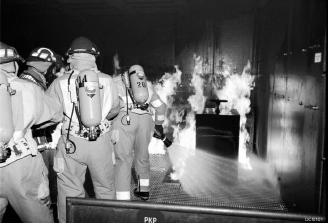
to the Catalog of Navy Training Courses (CANTRAC)
To attain these objectives, we must accomplish the
for the latest listing of courses available. This catalog is
following:
available from your Education Services Office (ESO).
1. Preserve stability and fume-tight and watertight
integrity (buoyancy).
2. Maintain the operational capabilities of vital
systems.
3. Prevent, isolate, combat, extinguish, and
remove the effects of fire and explosion.
4. Detect, confine, and remove the effects of
chemical, biological, or radiological
5. Prevent personnel casualties and administer first
aid to the injured.
Figure 1-1. Damage control team training.
6. Make rapid repairs to correct structural and
equipment damage.
Nonresident Training Course
AREAS OF RESPONSIBILITY
This nonresident training course (NRTC) is
The three primary areas of responsibility for
designed for the Damage Controlman rating. There are
damage control include the following:
other recommended courses that are good sources of
training; a good example is Blueprint Reading and
1. The functional combination of all equipment,
Sketching, NAVEDTRA 82014. This and other courses
material, devices, and techniques that prevent
may be ordered through your ESO.
and minimize damage and restore damaged
equipment and structures. This damage can
On-the-Job Training
occur in wartime or peacetime.
Another method of training is on-the-job training.
2. The passive defense against conventional,
This training method allows you to learn while
nuclear, biological, and chemical warfare.
performing your daily tasks. Your fellow workers and
3. All active defense measures short of those
supervisors may teach you by sharing their knowledge
designed to prevent successful delivery of an
with you. Additionally, you may learn on your own by
enemy attack by military means or sabotage.
studying applicable publications.
PROFESSIONAL DEVELOPMENT
On-the-job training is also carried out through
emergency drills. These drills help train emergency
Because damage control covers a wide variety of
party personnel to perform their assignments in a
areas, training is essential for an effective emergency
professional manner. The drills also train individuals
party. This training is accomplished in several ways.
You may learn through schools, correspondence
to work together as an effective unit.
courses, on-the-job training, shipboard training
Sources of Information
lectures, and films. Most of the training programs
There are many valuable sources of information
available are explained in the following paragraphs.
about damage control. Some of the more important of
Navy Schools
these sources of information that you should become
There are a number of Navy schools to train
familiar with are stated below.
personnel in damage control. Your damage control
M A N U FAC T U R E R S '
TECHNICAL
assistant normally requests quotas to send a complete
M A N UA L S . -- Yo u s h o u l d h ave a c c e s s t o t h e
repair party to a school as a unit. Members of the repair
manufacturer's technical manuals for your equipment.
parties train together and learn to work as a unit. These
These manuals provide information on the operation,
schools include shipboard damage control, shipboard
maintenance, and repair of a specific piece of
fire fighting, and aviation fire fighting. Figure 1-1
equipment, and you should always use the one for the
shows fire-fighting training being conducted at the
Damage Control School in Great Lakes, Illinois. Refer
equipment you are required to work on.
1-2

